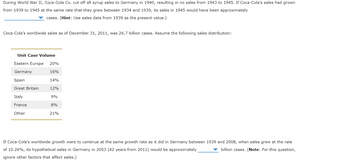Future value and present value concepts are applied in various ways, such as calculating growth rates, earnings per share, expected sales and revenues in the future, and so forth. Consider the following case: Pharmacist John S. Pemberton invented a soft drink in 1886 that eventually became not only an integral part of everyday life in the United States but also a symbol of consumerism worldwide. In 1929 the first Coca-Cola vending machines were installed in Germany, and in 1930, the German branch of the Coca-Cola Co. opened in Essen. Coca-Cola sales in Germany were 243,000 cases in 1934, 1 million cases in 1936, and 4.5 million cases in 1939. Germany was a growing market for Coca-Cola, along with other countries in Europe, before World War II. With the previous data given, calculate the company's sales growth rate for each time period in the following table:
Dividend Valuation
Dividend refers to a reward or cash that a company gives to its shareholders out of the profits. Dividends can be issued in various forms such as cash payment, stocks, or in any other form as per the company norms. It is usually a part of the profit that the company shares with its shareholders.
Dividend Discount Model
Dividend payments are generally paid to investors or shareholders of a company when the company earns profit for the year, thus representing growth. The dividend discount model is an important method used to forecast the price of a company’s stock. It is based on the computation methodology that the present value of all its future dividends is equivalent to the value of the company.
Capital Gains Yield
It may be referred to as the earnings generated on an investment over a particular period of time. It is generally expressed as a percentage and includes some dividends or interest earned by holding a particular security. Cases, where it is higher normally, indicate the higher income and lower risk. It is mostly computed on an annual basis and is different from the total return on investment. In case it becomes too high, indicates that either the stock prices are going down or the company is paying higher dividends.
Stock Valuation
In simple words, stock valuation is a tool to calculate the current price, or value, of a company. It is used to not only calculate the value of the company but help an investor decide if they want to buy, sell or hold a company's stocks.


Trending now
This is a popular solution!
Step by step
Solved in 2 steps










